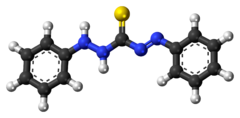Dithizone
 | |
 | |
| Names | |
|---|---|
| IUPAC name (1E)-3-anilino-1-phenylimino-thiourea | |
| Other names Diphenylthiocarbazone, 1,5-Diphenylthiocarbazone | |
| Identifiers | |
CAS Number |
|
3D model (JSmol) |
|
| ChemSpider |
|
| ECHA InfoCard | 100.000.413 |
PubChem CID |
|
| UNII |
|
CompTox Dashboard (EPA) |
|
InChI
| |
| |
| Properties | |
Chemical formula | C13H12N4S |
| Molar mass | 256.33 g·mol−1 |
| Hazards | |
| Safety data sheet (SDS) | External MSDS |
Except where otherwise noted, data are given for materials in their standard state (at 25 °C [77 °F], 100 kPa).  Y verify (what is Y verify (what is  Y Y N ?) N ?) Infobox references | |
Chemical compound
Dithizone is a sulfur-containing organic compound. It is a good ligand, and forms complexes with many toxic metals such as lead, thallium[1] and mercury.
Dithizone may be prepared by reacting phenylhydrazine with carbon disulfide, followed by reaction with potassium hydroxide.[2]
Dithizone is used to assess the purity of human pancreatic islet preparations used for transplantation into patients with type 1 diabetes. Dithizone binds zinc ions present in the islet's beta cells, and therefore stains the islets red. Exocrine tissue also present in the preparations does not bind dithizone, and is therefore not stained.
[3]
- Dithizone
- Dithizone in Ethanol 96%
References
- ^ Bendl BJ (1969) Thallium poisoning: report of a case successfully treated with dithizone. Arch Dermatol 100:443–446 URL=https://jamanetwork.com/journals/jamadermatology/article-abstract/531202
- ^ John H. Billman and Elizabeth S. Cleland (1955). "Dithizone". Organic Syntheses; Collected Volumes, vol. 3, p. 360.
- ^ Ricordi, C; Gray, DW; Hering, BJ; Kaufman, DB; Warnock, GL; Kneteman, NM; Lake, SP; London, NJ; et al. (1990). "Islet isolation assessment in man and large animals" (PDF). Acta Diabetologica Latina. 27 (3): 185–95. doi:10.1007/BF02581331. PMID 2075782.












